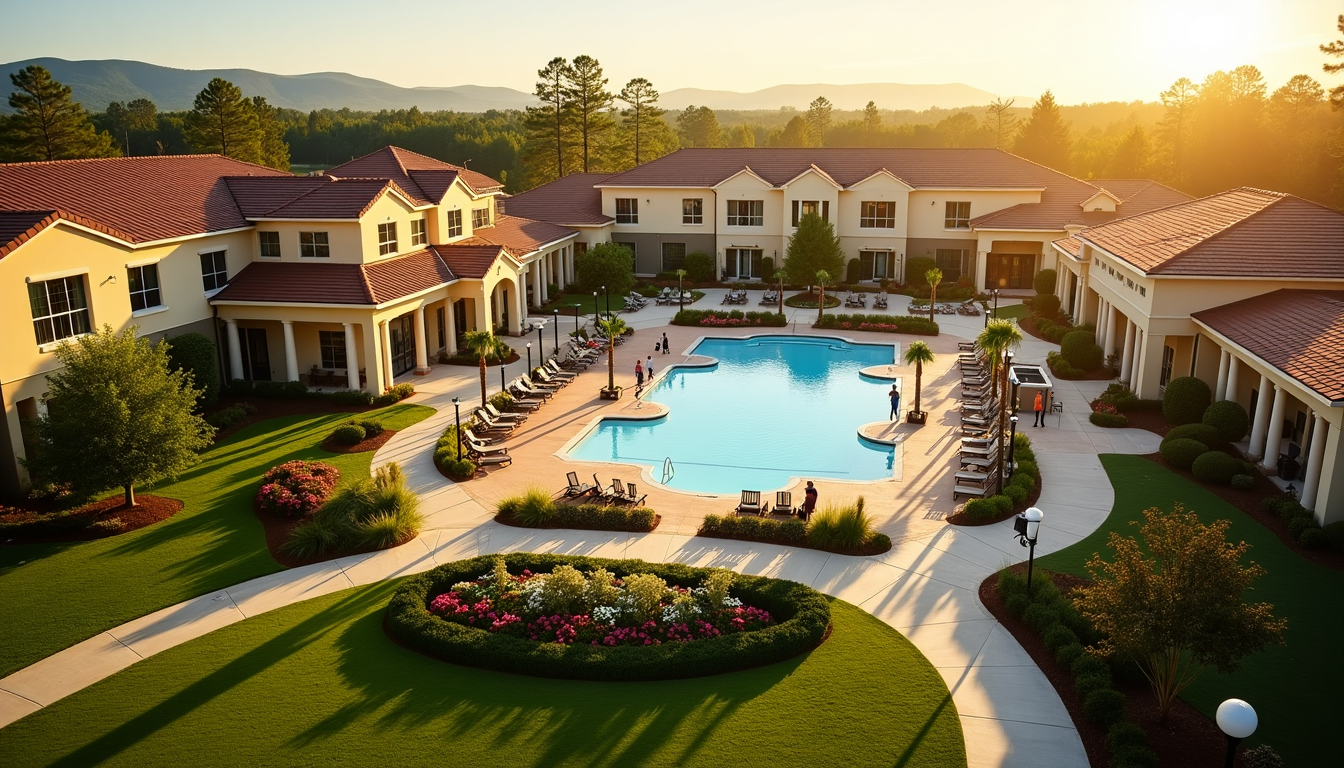Choosing the right assisted living facility is a crucial decision that can significantly impact the quality of life for seniors and their families. As the aging population grows, so does the need for reliable and comfortable care options. Understanding what to look for in an assisted living facility and knowing the right questions to ask when touring assisted living communities are essential steps in this important process.
This guide will provide valuable insights into selecting an appropriate assisted living facility. Readers will learn how to assess care needs and budget constraints, research facility credentials and safety measures, evaluate staff qualifications and resident care practices, and conduct effective facility tours. By exploring these key areas, individuals and families can make informed decisions to ensure their loved ones receive the best possible care and support in their new home.
Assess Your Care Needs and Budget
Determine required level of care
Assessing the level of care needed is a crucial step in choosing the right assisted living facility. This process involves evaluating a senior’s ability to perform activities of daily living (ADLs) independently. These activities include dressing, bathing, eating, and managing medications. A thorough assessment helps determine the appropriate level of assistance required, which can range from minimal support to more intensive care.
Many assisted living facilities conduct a needs-based assessment before a resident moves in. This evaluation typically involves a nurse or qualified staff member who examines the senior’s physical and cognitive health. The assessment helps create a personalized care plan and determines the associated costs. It’s important to answer all questions honestly during this process to ensure the facility can meet the senior’s needs adequately.
Evaluate financial resources
Understanding the financial aspects of assisted living is essential when considering this option. The average cost of assisted living in the United States is approximately $4,500 per month or $54,000 annually. However, these costs can vary significantly depending on factors such as location, amenities, and level of care required.
To evaluate financial resources, consider the following options:
- Personal savings and assets
- Social Security benefits
- Retirement accounts (401(k) or IRA)
- Pension payments
- Long-term care insurance
- Veterans benefits (for eligible individuals)
- Home equity or sale proceeds
It’s crucial to have a clear understanding of the pricing structure at each facility you’re considering. Some communities charge an all-inclusive monthly fee, while others itemize charges for each service. This information helps in comparing costs accurately and planning for future expenses.
Consider future care needs
When selecting an assisted living facility, it’s important to look beyond current care requirements and consider potential future needs. As seniors age, their care needs often increase, which can impact both the level of assistance required and the associated costs.
Life Plan Communities, also known as continuing care retirement communities (CCRCs), offer a range of living options from independent living to skilled nursing care. These communities provide the advantage of allowing residents to transition to higher levels of care within the same campus as their needs change.
When touring assisted living facilities, ask about their ability to accommodate changing care needs. Inquire about the availability of memory care units for residents who may develop dementia or Alzheimer’s disease in the future. Additionally, ask about the frequency of care plan reassessments and how changes in care needs might affect monthly costs.
By carefully assessing care needs, evaluating financial resources, and considering future requirements, seniors and their families can make informed decisions when choosing an assisted living facility. This approach helps ensure that the selected community can provide appropriate care and support both now and in the years to come.
Research Facility Credentials and Safety
Check licensing and certifications
When researching assisted living facilities, it’s crucial to verify their licensing and certifications. Each state has its own guidelines and licensing requirements for these communities, which means there are subtle differences in what they provide. Before opening, assisted living communities must obtain a license from the proper state agency. This agency then conducts routine inspections to ensure the facility maintains its license.
To obtain information about a facility’s background and licensing, families can contact their local Area Agency on Aging (AAoA) or speak with a Long Term Care Ombudsman. Some states have created consumer-friendly websites where people can investigate assisted living communities they are considering. These websites often allow users to verify a provider’s license and check for any recent issues or regulation violations.
Review inspection reports
Inspection reports provide valuable insights into a facility’s compliance with state and federal regulations. State survey agencies conduct health inspections of nursing homes at least once a year, and may inspect more frequently if the facility is performing poorly or if there are complaints. During these inspections, teams evaluate various aspects of life in the nursing home, including resident care, staff-resident interactions, and the overall environment.
When reviewing inspection reports, pay attention to any citations issued for non-compliance with federal standards. The federal government may impose penalties on nursing homes for serious citations or for those that remain uncorrected for an extended period. State governments may also impose penalties. It’s important to note that nursing homes have the opportunity to dispute citations through the Informal Dispute Resolution (IDR) process.
Evaluate safety features and protocols
Safety is paramount when choosing an assisted living facility. Essential safety features to look for include sprinkler systems, smoke detectors, and non-slip flooring. Sprinklers help quickly extinguish fires, giving residents more time to escape and reducing damage. Smoke detectors should be tested regularly in every room to ensure they’re in working condition.
Other important safety measures include bathroom grip bars, adequate lighting, and secure outdoor common spaces. Grip bars near toilets and in shower areas help prevent falls, while proper lighting in hallways, common areas, and residents’ rooms reduces the risk of accidents. Secure outdoor spaces allow residents to enjoy fresh air and social activities without the risk of wandering off or encountering potential harm.
When touring facilities, ask about their safety protocols, including how they handle emergencies, conduct wellness checks, and train staff. Well-trained staff should be familiar with safety protocols and able to handle emergencies quickly and correctly. Regular wellness checks help monitor residents’ health and ensure they’re taking medications properly and eating well.
By thoroughly researching facility credentials and safety measures, families can make informed decisions when choosing an assisted living facility for their loved ones. This diligence helps ensure that residents receive quality care in a secure environment.
Evaluate Staff Qualifications and Resident Care
When choosing an assisted living facility, it’s crucial to evaluate staff qualifications and resident care practices. This assessment helps ensure that your loved one will receive high-quality care in a safe and supportive environment. Here are some key areas to consider when evaluating staff qualifications and resident care in assisted living facilities.
Inquire about staff-to-resident ratios
One of the most important questions to ask when touring assisted living facilities is about their staff-to-resident ratios. The industry average for assisted living communities is typically 1:8, meaning one caregiver for every eight residents. However, this ratio may vary depending on the time of day and the specific needs of residents.
It’s essential to ask about the staff-to-resident ratio during both day and night shifts. Some communities may have a lower ratio at night, such as 1:15, when residents are usually sleeping. A higher staff-to-resident ratio often results in more personalized care, as caregivers have more time to attend to each resident’s needs.
When touring facilities, consider asking these questions:
- What is the caregiver-to-resident ratio during the day and night?
- Are at least two caregivers on-site at all times?
- How do staff ratios change based on residents’ care needs?
Ask about staff training and qualifications
Staff training plays a vital role in ensuring the well-being and safety of residents in assisted living facilities. Proper training equips caregivers with the knowledge and skills necessary to provide quality care and support. When evaluating facilities, inquire about their staff training programs and qualifications.
Key areas to explore include:
- Initial orientation and ongoing training requirements for staff
- Specialized training for dementia care, medication management, and emergency preparedness
- Certifications and qualifications of caregivers and nurses
Look for facilities that prioritize comprehensive training programs covering various aspects of senior care, including emergency response, fall prevention, and communication skills.
Understand care planning process
The care planning process is an essential component of assisted living care. It involves creating a personalized approach to address each resident’s specific needs and preferences. When evaluating facilities, ask about their care planning process and how they tailor services to individual residents.
Key points to consider:
- How often are care plans reviewed and updated?
- Who is involved in the care planning process?
- How are residents’ preferences and goals incorporated into the care plan?
A well-designed care plan should outline the services and supports a senior needs, identify who is responsible for providing them, and include a timeframe for reevaluation. This approach ensures that residents receive personalized care that adapts to their changing needs over time.
By thoroughly evaluating staff qualifications, resident care practices, and the care planning process, you can make an informed decision when choosing an assisted living facility for your loved one. Remember to ask plenty of questions during your tour and observe how staff interact with residents to get a sense of the overall care environment.
Tour Facilities and Ask Key Questions
Touring assisted living facilities is a crucial step in finding the right home for a loved one. During these visits, it’s essential to observe various aspects of the community and ask pertinent questions to ensure it meets the needs and preferences of the potential resident. Here are some key areas to focus on during your tour:
Observe cleanliness and maintenance
The cleanliness of a facility is a strong indicator of its overall quality and attention to detail. As you walk through the community, pay close attention to the following:
• Tidiness of common areas, dining rooms, and hallways • Absence of unpleasant odors • Well-maintained outdoor spaces • Cleanliness of private rooms and bathrooms • Frequency of housekeeping services
A clean and well-maintained environment not only contributes to the residents’ health and safety but also reflects the community’s commitment to providing a comfortable living space.
Evaluate dining options and meal plans
Food quality and dining experiences play a significant role in residents’ satisfaction. To get a better understanding of the dining services, consider the following questions to ask when touring assisted living:
• Can you sample a meal during your visit? • What are the dining hours, and are they flexible? • Are special dietary needs accommodated? • Is there a variety of menu options? • Are snacks and beverages available throughout the day? • Can family members join residents for meals?
Many communities offer multiple dining venues, such as a main dining room and a more casual café or bistro, providing residents with diverse dining experiences.
Ask about activities and social engagement
Social interaction is vital for seniors’ well-being, so inquire about the community’s approach to activities and engagement. Some questions to ask when looking for an assisted living facility include:
• What types of activities are offered? • Is there a monthly calendar of events? • Are there opportunities for outings and off-site activities? • How does the staff encourage resident participation? • Are there clubs or special interest groups? • Can residents suggest or lead activities?
Look for communities that offer a variety of programming, including physical, social, intellectual, creative, and spiritual activities. This diversity ensures that residents with different interests and abilities can find engaging ways to spend their time.
By thoroughly observing these aspects and asking thoughtful questions during your tour, you’ll gain valuable insights into what to look for in an assisted living facility. This information will help you make an informed decision and find a community that provides a safe, comfortable, and enriching environment for your loved one.
Conclusion
Choosing the right assisted living facility has a significant impact on the quality of life for seniors and their families. This guide has highlighted key areas to consider, including assessing care needs and budget, researching facility credentials and safety measures, evaluating staff qualifications and resident care practices, and conducting thorough facility tours. By focusing on these aspects, families can make well-informed decisions to ensure their loved ones receive top-notch care and support in their new home.
Remember, finding the perfect assisted living facility is a process that requires time, research, and careful consideration. Don’t hesitate to ask plenty of questions, visit multiple facilities, and trust your instincts when making this important choice. With the right approach, you can find a community that not only meets your loved one’s current needs but also provides a warm, engaging, and supportive environment for years to come.
FAQs
What are the main challenges to consider when searching for an assisted living facility? When looking for an assisted living facility, it’s important to consider several challenges that might arise. Key issues include managing financial constraints, ensuring the facility is well-located and accessible, and verifying the quality of care and services offered.
What factors should families evaluate before selecting an assisted living facility? Families should carefully assess several factors before choosing an assisted living facility. These include the level of care the facility provides, the safety and security measures in place, and the quality of the staff employed there.
At what age is it appropriate to consider moving to an assisted living facility? There is no specific age that is considered ideal for transitioning to an assisted living facility. The decision is personal and can vary widely, but it’s not uncommon for residents to start living in these communities from the age of 62 and continue into their nineties and beyond.
How can you tell if a loved one might need to move into an assisted living facility? Signs that a loved one may require assisted living can include noticeable neglect of their living space. Difficulty in performing daily tasks such as vacuuming, taking out the trash, washing dishes, or managing other household duties may indicate the need for additional support.




